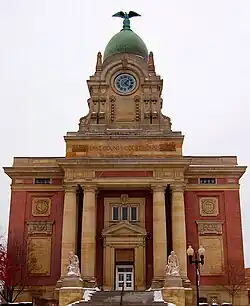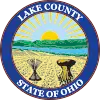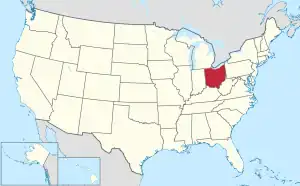Lake County, Ohio
Lake County is a county in the U.S. state of Ohio. As of the 2020 census, the population was 232,603.[2] Its county seat is Painesville, and its largest city is Mentor.
Lake County | |
|---|---|
 Lake County Courthouse | |
 Seal  Logo | |
 Location within the U.S. state of Ohio | |
 Ohio's location within the U.S. | |
| Coordinates: 41°49′N 81°14′W | |
| Country | |
| State | |
| Founded | March 6, 1840[1] |
| Named for | Lake Erie |
| Seat | Painesville |
| Largest city | Mentor |
| Area | |
| • Total | 979 sq mi (2,540 km2) |
| • Land | 227 sq mi (590 km2) |
| • Water | 752 sq mi (1,950 km2) 77% |
| Population (2020) | |
| • Total | 232,603 |
| • Estimate (2021) | 232,023 |
| • Density | 240/sq mi (92/km2) |
| Time zone | UTC−5 (Eastern) |
| • Summer (DST) | UTC−4 (EDT) |
| Congressional district | 14th |
| Website | www |
The county was established on March 6, 1840, from land given by Cuyahoga and Geauga counties. Its name is derived from its location on the southern shore of Lake Erie.[3] Lake County is part of the Cleveland, OH Metropolitan Statistical Area.
History
The land that became Lake County was home to the indigenous Erie people prior to the arrival of the French in the region during the early 1600s, and considered by the French to be part of their Colony of New France. Ceded to Great Britain in 1763, the area became part of the Province of Quebec through the Quebec Act of 1774. Following the American Revolutionary War, it became part of the Connecticut Western Reserve in the Northwest Territory, then was purchased by the Connecticut Land Company in 1795. It was separated out of Geauga County in March 1840.
Geography
According to the United States Census Bureau, the county has an area of 979 square miles (2,540 km2), of which 227 square miles (590 km2) is land and 752 square miles (1,950 km2) (77%) is water.[4] It is Ohio's smallest county by land area but the third-largest by total area. It borders Ontario across Lake Erie.
Adjacent counties
- Ashtabula County (east)
- Geauga County (south)
- Cuyahoga County (southwest)
Major highways
National protected area
Physical geography
Ridges on the Lake Plain physiographic region, and on which some roads are laid, are beaches formed by the various glacial lakes which occurred as the glaciers receded.[5] Lake Maumee was the highest glacial lake at about 760 feet, and left Maumee II beach. Whittlesey beach, formed by Lake Whittlesey at 740 feet, is known as South Ridge. Arkona beach (Lake Arkona) is Middle Ridge, and occurs at about 690 feet. North Ridge is the remnant of Warren beach (Lake Warren), at an elevation of 685 feet. Elkton beach is the northernmost ridge, at 625 feet, an occurred at the time of Lake Elkton. Lake Shore Boulevard follows Elkton beach in Mentor Township.
Mentor Marsh is an Ohio State Nature Preserve.[6] Mentor Marsh is an abandoned channel of the Grand River.
Demographics
| Census | Pop. | Note | %± |
|---|---|---|---|
| 1840 | 13,719 | — | |
| 1850 | 14,654 | 6.8% | |
| 1860 | 15,576 | 6.3% | |
| 1870 | 15,935 | 2.3% | |
| 1880 | 16,326 | 2.5% | |
| 1890 | 18,235 | 11.7% | |
| 1900 | 21,680 | 18.9% | |
| 1910 | 22,927 | 5.8% | |
| 1920 | 28,667 | 25.0% | |
| 1930 | 41,674 | 45.4% | |
| 1940 | 50,020 | 20.0% | |
| 1950 | 75,979 | 51.9% | |
| 1960 | 148,700 | 95.7% | |
| 1970 | 197,200 | 32.6% | |
| 1980 | 212,801 | 7.9% | |
| 1990 | 215,499 | 1.3% | |
| 2000 | 227,511 | 5.6% | |
| 2010 | 230,041 | 1.1% | |
| 2020 | 232,603 | 1.1% | |
| 2021 (est.) | 232,023 | [7] | −0.2% |
| U.S. Decennial Census[8] 1790-1960[9] 1900-1990[10] 1990-2000[11] 2010-2020[2] | |||
In 2010, 92.4% spoke English, 2.7% Spanish, and 1.4% Croatian.[12]
2000 census
As of the census[13] of 2000, the county had 227,511 people, 89,700 households, and 62,520 families. The population density was 997 inhabitants per square mile (385/km2). There were 93,487 housing units at an average density of 410 units per square mile (160 units/km2). The county's racial makeup was 95.40% White, 1.99% Black or African American, 0.11% Native American, 0.90% Asian, 0.02% Pacific Islander, 0.66% from other races, and 0.92% from two or more races. 1.70% of the population were Hispanic or Latino of any race. 18.5% were of German, 14.6% Italian, 12.7% Irish, 8.1% English, 6.2% Polish, 5.7% American and 5.4% Slovene ancestry. 93.6% spoke English, 1.9% Spanish, and 0.8% Croatian as their first language.[12]
There were 89,700 households, out of which 31.10% had children under the age of 18 living with them, 56.10% were married couples living together, 10.00% had a female householder with no husband present, and 30.30% were non-families. 25.60% of all households were made up of individuals, and 9.80% had someone living alone who was 65 years of age or older. The average household size was 2.50 and the average family size was 3.03.
The county's population was spread out, with 24.20% under the age of 18, 7.30% from 18 to 24, 29.70% from 25 to 44, 24.70% from 45 to 64, and 14.10% who were 65 years of age or older. The median age was 39 years. For every 100 females there were 94.50 males. For every 100 females age 18 and over, there were 91.50 males.
The county's median household income was $48,763, and the median family income was $57,134. Males had a median income of $40,916 versus $28,434 for females. The county's per capita income was $23,160. About 3.50% of families and 5.10% of the population were below the poverty line, including 6.50% of those under age 18 and 5.40% of those age 65 or over.
2010 census
As of the 2010 census, there were 230,041 people, 94,156 households, and 62,384 families residing in the county.[14] The population density was 1,011.2 inhabitants per square mile (390.4/km2). There were 101,202 housing units at an average density of 444.9 units per square mile (171.8 units/km2).[15] The racial makeup of the county was 92.5% white, 3.2% black or African American, 1.1% Asian, 0.1% American Indian, 1.6% from other races, and 1.5% from two or more races. Those of Hispanic or Latino origin made up 3.4% of the population.[14] In terms of ancestry, 26.4% were German, 18.9% were Irish, 16.4% were Italian, 11.5% were English, 7.6% were Polish, 5.4% were Hungarian, and 3.9% were American.[16]
Of the 94,156 households, 29.4% had children under the age of 18 living with them, 50.5% were married couples living together, 11.2% had a female householder with no husband present, 33.7% were non-families, and 28.3% of all households were made up of individuals. The average household size was 2.41 and the average family size was 2.97. The median age was 42.3 years.[14]
The median income for a household in the county was $54,896 and the median income for a family was $67,206. Males had a median income of $49,240 versus $36,906 for females. The per capita income for the county was $28,221. About 6.0% of families and 8.1% of the population were below the poverty line, including 13.0% of those under age 18 and 4.4% of those age 65 or over.[17]
Environment
Scorecard[18] report from 2002 ranks Lake County among the worst 10% of counties in the U.S. in terms of cancer risk, developmental and reproductive toxicants, and other categories as well; this is comparable with most major cities and densely populated areas. Scorecard[18] In 2004, this county ranked among the cleanest/best 10% of all counties in the U.S. in terms of the number of designated Superfund sites.
Lake County has a large public park system, including Lake Metroparks Farmpark. Kirtland is home to the Holden Arboretum and Gildersleeve Mountain. Headlands Beach State Park is in Mentor. The Grand River is a state wild and scenic river and the Chagrin River is a state scenic river.
Transportation
Laketran is the transit agency servicing Lake County. Interstate 90 runs northeast–southwest through Lake County, roughly parallel to State Route 2; along with the north–south State Route 44 connecting the two together. These freeways make up the major traffic arteries in the county. Lake County does not have passenger rail service, though Amtrak's New York City-Chicago "Lake Shore Limited" service schedules an eastbound and westbound train through Lake County nightly with stops at Cleveland and Erie. CSXT (former Conrail, née-Penn Central, née-New York Central) and Norfolk Southern (née-Norfolk & Western, née-Nickel Plate Road) provide railroad main line through-freight service. The recently formed Grand River Railroad, operating on former Baltimore & Ohio track, serves the Fairport Harbor area linking the Morton Salt plant with CSXT at Painesville.
Library services
The following libraries serve Lake County:
- Fairport Harbor Public Library in Fairport Harbor
- Kirtland Public Library in Kirtland
- Madison Public Library in Madison
- Mentor Public Library in Mentor
- Morley Library in Painesville
- Perry Public Library in Perry
- Wickliffe Public Library in Wickliffe. WKPL is "A Top Ten American Library" as rated by the HAPLR Index.[19] In 2005, the library loaned more than 459,000 items to its 110,400 cardholders. Total holdings are over 100,000 volumes with over 519 periodical subscriptions.[20]
- Willoughby-Eastlake Public Library, headquartered in Eastlake with branches in Eastlake, Willoughby, Willoughby Hills, and Willowick. In 2005, the library loaned more than 1.2 million items to its 37,000 cardholders. Total holding are over 216,000 volumes with over 850 periodical subscriptions.[20]
Additionally, as of 2019, all Lake County libraries are all CLEVNET members.
Politics
Lake County is known as a "purple" or "swing" county within the state. A 2008 analysis of Ohio presidential election results from 1960 to 2004 found no other county more closely follows the statewide Ohio voting pattern.[21] Lake County does not always vote with the winner, but consistently is closer to the winner's Ohio vote percentage than any other Ohio county.
| Year | Republican | Democratic | Third party | |||
|---|---|---|---|---|---|---|
| No. | % | No. | % | No. | % | |
| 2020 | 73,278 | 56.03% | 55,514 | 42.45% | 1,990 | 1.52% |
| 2016 | 64,255 | 54.83% | 46,397 | 39.59% | 6,538 | 5.58% |
| 2012 | 58,744 | 49.50% | 57,680 | 48.61% | 2,241 | 1.89% |
| 2008 | 59,142 | 48.62% | 60,155 | 49.45% | 2,345 | 1.93% |
| 2004 | 62,193 | 51.05% | 59,049 | 48.47% | 581 | 0.48% |
| 2000 | 51,747 | 50.45% | 46,497 | 45.33% | 4,320 | 4.21% |
| 1996 | 40,974 | 41.92% | 43,186 | 44.19% | 13,576 | 13.89% |
| 1992 | 40,766 | 38.46% | 37,682 | 35.55% | 27,542 | 25.99% |
| 1988 | 52,963 | 56.63% | 39,667 | 42.41% | 894 | 0.96% |
| 1984 | 54,587 | 59.12% | 36,711 | 39.76% | 1,027 | 1.11% |
| 1980 | 43,485 | 50.31% | 35,246 | 40.78% | 7,697 | 8.91% |
| 1976 | 36,390 | 45.83% | 40,734 | 51.30% | 2,284 | 2.88% |
| 1972 | 42,488 | 58.90% | 27,523 | 38.15% | 2,130 | 2.95% |
| 1968 | 28,450 | 43.40% | 27,932 | 42.61% | 9,177 | 14.00% |
| 1964 | 23,282 | 37.65% | 38,552 | 62.35% | 0 | 0.00% |
| 1960 | 32,038 | 48.94% | 33,425 | 51.06% | 0 | 0.00% |
| 1956 | 31,017 | 61.14% | 19,718 | 38.86% | 0 | 0.00% |
| 1952 | 23,483 | 60.48% | 15,346 | 39.52% | 0 | 0.00% |
| 1948 | 12,973 | 53.81% | 10,844 | 44.98% | 291 | 1.21% |
| 1944 | 13,697 | 51.86% | 12,713 | 48.14% | 0 | 0.00% |
| 1940 | 13,464 | 52.04% | 12,408 | 47.96% | 0 | 0.00% |
| 1936 | 9,386 | 43.24% | 11,213 | 51.66% | 1,108 | 5.10% |
| 1932 | 11,792 | 61.43% | 6,801 | 35.43% | 603 | 3.14% |
| 1928 | 11,823 | 74.24% | 4,024 | 25.27% | 79 | 0.50% |
| 1924 | 7,727 | 70.71% | 974 | 8.91% | 2,226 | 20.37% |
| 1920 | 7,465 | 72.31% | 2,711 | 26.26% | 147 | 1.42% |
| 1916 | 2,887 | 51.39% | 2,596 | 46.21% | 135 | 2.40% |
| 1912 | 1,155 | 22.91% | 1,429 | 28.34% | 2,458 | 48.75% |
| 1908 | 3,635 | 66.97% | 1,605 | 29.57% | 188 | 3.46% |
| 1904 | 3,824 | 76.42% | 871 | 17.41% | 309 | 6.18% |
| 1900 | 3,929 | 68.41% | 1,733 | 30.18% | 81 | 1.41% |
| 1896 | 3,745 | 68.40% | 1,682 | 30.72% | 48 | 0.88% |
| 1892 | 2,846 | 67.46% | 1,158 | 27.45% | 215 | 5.10% |
| 1888 | 2,987 | 68.37% | 1,157 | 26.48% | 225 | 5.15% |
| 1884 | 2,925 | 69.64% | 1,120 | 26.67% | 155 | 3.69% |
| 1880 | 2,978 | 71.06% | 1,104 | 26.34% | 109 | 2.60% |
| 1876 | 2,941 | 71.28% | 1,141 | 27.65% | 44 | 1.07% |
| 1872 | 2,751 | 73.56% | 979 | 26.18% | 10 | 0.27% |
| 1868 | 2,909 | 76.59% | 889 | 23.41% | 0 | 0.00% |
| 1864 | 2,787 | 82.63% | 586 | 17.37% | 0 | 0.00% |
| 1860 | 2,521 | 77.74% | 622 | 19.18% | 100 | 3.08% |
| 1856 | 2,371 | 78.04% | 628 | 20.67% | 39 | 1.28% |
Communities

Cities
Villages
Townships
Census-designated place
Unincorporated communities
See also
- Burning River Buckets, 2023 ABA Champions
- Melon heads, a local urban legend
- National Register of Historic Places listings in Lake County, Ohio
- Historic Country Estates in Lake County, Ohio
References
- "Ohio County Profiles: Lake County" (PDF). Ohio Department of Development. Archived from the original (PDF) on March 18, 2004. Retrieved April 28, 2007.
- "State & County QuickFacts". United States Census Bureau. Retrieved July 14, 2022.
- "Lake County data". Ohio State University Extension Data Center. Retrieved April 28, 2007.
- "2010 Census Gazetteer Files". United States Census Bureau. August 22, 2012. Archived from the original on May 4, 2014. Retrieved February 8, 2015.
- White, George W. (1980). Glacial Geology of Lake County, Ohio (PDF). Columbus, Ohio: State of Ohio Department of Natural Resources Division of Geological Survey. p. 8.
- "Mentor Marsh State Nature Preserve". State of Ohio Department of Natural Resources. Retrieved October 26, 2019.
- "Annual Estimates of the Resident Population for Counties: April 1, 2020 to July 1, 2021". Retrieved July 14, 2022.
- "U.S. Decennial Census". United States Census Bureau. Retrieved February 8, 2015.
- "Historical Census Browser". University of Virginia Library. Retrieved February 8, 2015.
- Forstall, Richard L., ed. (March 27, 1995). "Population of Counties by Decennial Census: 1900 to 1990". United States Census Bureau. Retrieved February 8, 2015.
- "Census 2000 PHC-T-4. Ranking Tables for Counties: 1990 and 2000" (PDF). United States Census Bureau. April 2, 2001. Archived (PDF) from the original on March 27, 2010. Retrieved February 8, 2015.
- "Data Center Results". Archived from the original on August 15, 2013. Retrieved August 7, 2013.
- "U.S. Census website". United States Census Bureau. Retrieved January 31, 2008.
- "DP-1 Profile of General Population and Housing Characteristics: 2010 Demographic Profile Data". United States Census Bureau. Archived from the original on February 13, 2020. Retrieved December 27, 2015.
- "Population, Housing Units, Area, and Density: 2010 - County". United States Census Bureau. Archived from the original on February 13, 2020. Retrieved December 27, 2015.
- "DP02 SELECTED SOCIAL CHARACTERISTICS IN THE UNITED STATES – 2006-2010 American Community Survey 5-Year Estimates". United States Census Bureau. Archived from the original on February 13, 2020. Retrieved December 27, 2015.
- "DP03 SELECTED ECONOMIC CHARACTERISTICS – 2006-2010 American Community Survey 5-Year Estimates". United States Census Bureau. Archived from the original on February 13, 2020. Retrieved December 27, 2015.
- "scorecard.org". Archived from the original on May 6, 2021. Retrieved May 29, 2021.
- "HAPLR Top Ten by Population". HAPLR Index. Archived from the original on March 23, 2009. Retrieved December 26, 2009.
- "2005 Ohio Public Library Statistics:Statistics by County and Town". State Library of Ohio. Archived from the original on September 24, 2006. Retrieved October 28, 2006.
- Exner, Rich (August 19, 2008). "Ohio's presidential election bellwether: Lake County". Cleveland Plain Dealer. Archived from the original on October 26, 2012. Retrieved June 24, 2012.
- Leip, David. "Dave Leip's Atlas of U.S. Presidential Elections". uselectionatlas.org. Retrieved May 2, 2018.
